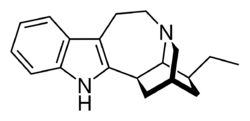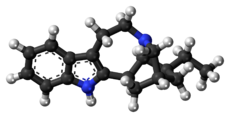Chemistry:Ibogamine
 | |
 | |
| Clinical data | |
|---|---|
| ATC code |
|
| Identifiers | |
| |
| CAS Number | |
| PubChem CID | |
| ChemSpider | |
| ChEBI | |
| Chemical and physical data | |
| Formula | C19H24N2 |
| Molar mass | 280.415 g·mol−1 |
| 3D model (JSmol) | |
| |
| |
| | |
Ibogamine is an anti-convulsant, anti-addictive, CNS stimulant alkaloid found in Tabernanthe iboga and Crepe Jasmine (Tabernaemontana divaricata).[1][2][3] Basic research related to how addiction affects the brain has used this chemical.[4]
Ibogamine persistently reduced the self-administration of cocaine and morphine in rats.[5] The same study found that ibogamine (40 mg/kg) and coronaridine (40 mg/kg) did not produce "any tremor effects in rats that differ significantly from saline control". While the related alkaloids ibogaine (20–40 mg/kg), harmaline (10–40 mg/kg) and desethylcoronaridine (10–40 mg/kg) were "obviously tremorgenic".[5]
Chemistry
Synthesis
Ibogamine can be prepared from one-step demethoxycarbonylation process through coronaridine.[6]
Pharmacology
Like ibogaine, it has seems to have similar pharmacology. It has effects on KOR,[7] NMDAR, nAChR[8] and serotonin sites.[9] It also inhibits acetylcholinesterase and butyrylcholinesterase.[10]
See also
References
- ↑ "The Alkaloids of Tabernanthe iboga. Part IV.1 The Structures of Ibogamine, Ibogaine, Tabernanthine and Voacangine". Journal of the American Chemical Society 80 (1): 126–136. 1958. doi:10.1021/ja01534a036.
- ↑ "A synthesis of ibogamine". The Journal of Organic Chemistry 50 (9): 1464–1467. 1985. doi:10.1021/jo00209a020.
- ↑ "New alkaloids from Tabernaemontana divaricata.". Phytochemistry 19 (6): 1209–1212. January 1980. doi:10.1016/0031-9422(80)83085-8. Bibcode: 1980PChem..19.1209R.
- ↑ "A review of chemical agents in the pharmacotherapy of addiction". Current Medicinal Chemistry 9 (20): 1807–1818. October 2002. doi:10.2174/0929867023368980. PMID 12369879.
- ↑ 5.0 5.1 "Effects of iboga alkaloids on morphine and cocaine self-administration in rats: relationship to tremorigenic effects and to effects on dopamine release in nucleus accumbens and striatum". Brain Research 657 (1–2): 14–22. September 1994. doi:10.1016/0006-8993(94)90948-2. PMID 7820611.
- ↑ "Extraction and Conversion Studies of the Antiaddictive Alkaloids Coronaridine, Ibogamine, Voacangine, and Ibogaine from Two Mexican Tabernaemontana Species (Apocynaceae)". Chemistry & Biodiversity 16 (7): e1900175. July 2019. doi:10.1002/cbdv.201900175. PMID 31095891.
- ↑ "Mechanisms of action of ibogaine and harmaline congeners based on radioligand binding studies". Brain Research 571 (2): 242–247. February 1992. doi:10.1016/0006-8993(92)90661-R. PMID 1377086.
- ↑ "Coronaridine congeners inhibit human α3β4 nicotinic acetylcholine receptors by interacting with luminal and non-luminal sites". The International Journal of Biochemistry & Cell Biology 65: 81–90. August 2015. doi:10.1016/j.biocel.2015.05.015. PMID 26022277.
- ↑ "Ethnobotany & ethnopharmacology of Tabernaemontana divaricata.". Free Online Library. https://www.thefreelibrary.com/Ethnobotany+%26+ethnopharmacology+of+Tabernaemontana+divaricata.-a0181406119.
- ↑ "Two fast screening methods (GC-MS and TLC-ChEI assay) for rapid evaluation of potential anticholinesterasic indole alkaloids in complex mixtures". Anais da Academia Brasileira de Ciências 80 (3): 419–426. September 2008. doi:10.1590/s0001-37652008000300003. PMID 18797794. https://www.scielo.br/pdf/aabc/v80n3/a03v80n3.pdf.
 |
